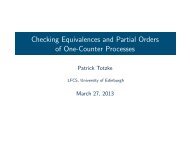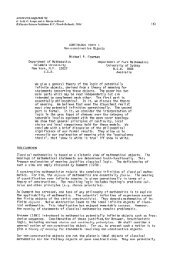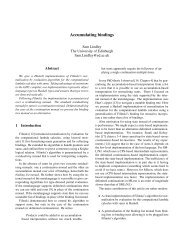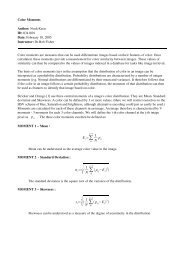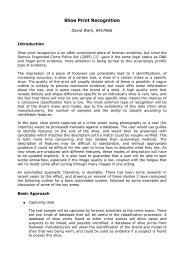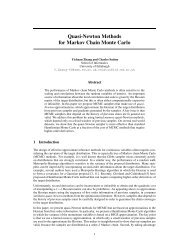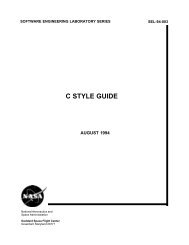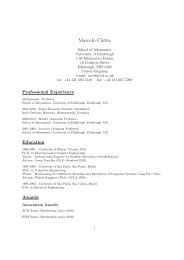The Effectiveness of Health Care Teams in the National Health Service
The Effectiveness of Health Care Teams in the National Health Service
The Effectiveness of Health Care Teams in the National Health Service
You also want an ePaper? Increase the reach of your titles
YUMPU automatically turns print PDFs into web optimized ePapers that Google loves.
Pritchard, Jones, Roth, Stueb<strong>in</strong>g and Ekeberg (1988) tested some <strong>of</strong> <strong>the</strong>se ideas by<br />
measur<strong>in</strong>g <strong>the</strong> effects <strong>of</strong> team feedback, goal sett<strong>in</strong>g and <strong>in</strong>centives on productivity.<br />
Five organisational units <strong>in</strong> <strong>the</strong> military were studied. One, a ma<strong>in</strong>tenance section,<br />
repaired a variety <strong>of</strong> electronic equipment used for aircraft communications. <strong>The</strong><br />
o<strong>the</strong>r four sections toge<strong>the</strong>r made up a material storage and distribution branch.<br />
Productivity basel<strong>in</strong>es were established before each team received new "treatments"<br />
(i.e., performance feedback eight months after <strong>the</strong> study began, goal sett<strong>in</strong>g five<br />
months later, and <strong>in</strong>centives a fur<strong>the</strong>r five months later) to determ<strong>in</strong>e <strong>the</strong> <strong>in</strong>cremental<br />
effects <strong>of</strong> <strong>the</strong>se "treatments". First, <strong>the</strong> level <strong>of</strong> performance <strong>of</strong> <strong>the</strong> teams was<br />
measured over a period <strong>of</strong> eight months and <strong>the</strong>n <strong>in</strong>formation on <strong>the</strong>ir performance<br />
was given to each unit for five months. <strong>The</strong> teams next set clear targets <strong>in</strong> addition to<br />
<strong>the</strong> performance feedback, and <strong>the</strong>ir performance was measured for ano<strong>the</strong>r five<br />
months. Feedback was <strong>in</strong> <strong>the</strong> form <strong>of</strong> computer-generated reports, given monthly to<br />
<strong>the</strong> personnel <strong>of</strong> each unit. F<strong>in</strong>ally, <strong>in</strong>centives were <strong>of</strong>fered for high performance, <strong>in</strong><br />
<strong>the</strong> form <strong>of</strong> time <strong>of</strong>f from work. Us<strong>in</strong>g <strong>the</strong>se approaches, <strong>the</strong> average <strong>in</strong>crease over<br />
basel<strong>in</strong>e productivity was 50% for feedback, 75% for goal sett<strong>in</strong>g and 76% for<br />
<strong>in</strong>centives. <strong>The</strong> results showed a major <strong>in</strong>crease <strong>in</strong> productivity among <strong>the</strong> teams,<br />
though <strong>the</strong> unique contribution <strong>of</strong> each component <strong>of</strong> <strong>the</strong> <strong>in</strong>tervention is difficult to<br />
estimate accurately. Both goal sett<strong>in</strong>g and feedback had powerful effects on<br />
performance.<br />
Transition <strong>of</strong> organisations to teamwork<strong>in</strong>g<br />
One <strong>of</strong> <strong>the</strong> most excit<strong>in</strong>g developments <strong>in</strong> <strong>the</strong> field is <strong>the</strong> new emphasis upon <strong>the</strong><br />
development <strong>of</strong> team-based work<strong>in</strong>g <strong>in</strong> organisations (Mohrman, et. al., 1995;<br />
Markiewicz & West, 1996, 2001). This reflects a concern amongst practitioners with<br />
how team-based work<strong>in</strong>g can be effectively <strong>in</strong>troduced <strong>in</strong>to organisations. Mohrman<br />
et. al., studied 25 teams <strong>in</strong> four companies us<strong>in</strong>g a grounded research methodology,<br />
<strong>in</strong>volv<strong>in</strong>g managers and <strong>in</strong>ternal customers. In <strong>the</strong> second phase <strong>of</strong> <strong>the</strong>ir research<br />
<strong>the</strong>y surveyed 178 teams across seven corporations, <strong>in</strong>volv<strong>in</strong>g team members,<br />
managers and customers. In this way, <strong>the</strong>y developed a five stage design sequence<br />
for <strong>the</strong> transition to a team-based organisation:<br />
1. Identify<strong>in</strong>g work teams and <strong>the</strong> nature <strong>of</strong> <strong>the</strong> task<br />
This <strong>in</strong>volves process analysis to determ<strong>in</strong>e essential work activities that have to be<br />
conducted and <strong>in</strong>tegrated to produce products or services; deliberations analysis<br />
which identifies dialogues about issues that have to be repeatedly resolved <strong>in</strong> order



